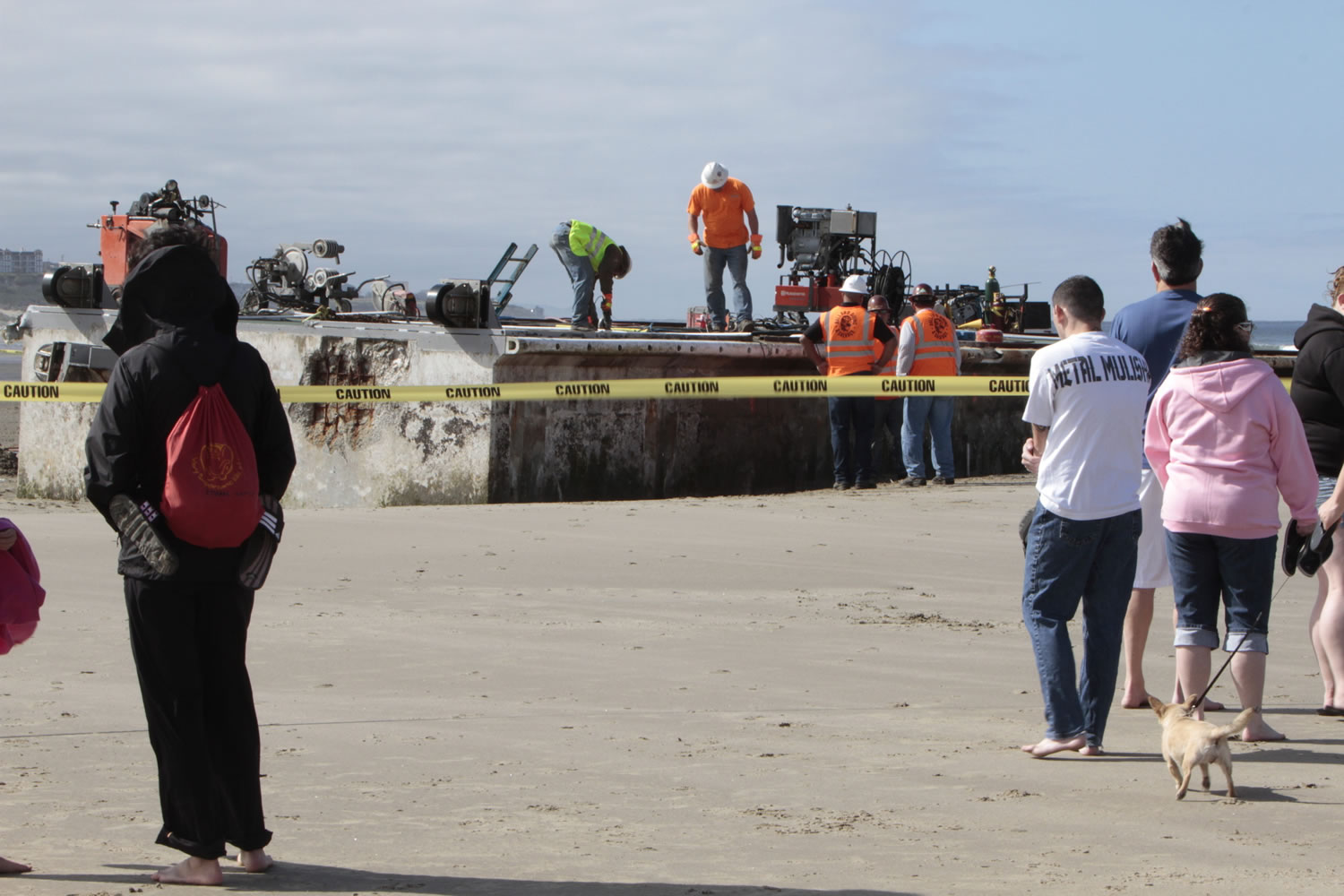With a crowd of spectators lounging in lawn chairs and snapping photos, workers on Wednesday started cutting up the boxcar-sized Japanese dock that was torn away from a fishing port by last year’s tsunami and washed up on an Oregon beach.
The plan is to cut the 165-ton concrete dock into five slices, like a loaf of bread, using a piece of equipment called a wire saw. If all goes well, the work should be finished by Thursday, leaving nothing but a depression in the sand until the ocean waves fill the beach back in again.
“We really are trying to keep in mind that this came from a massive disaster in Japan and try to treat it with the respect it deserves,” Scott Korab, director of business development for Ballard Diving and Salvage. The company, which recently relocated its administrative offices from Vancouver to Washougal, is performing the work of slicing up the dock.
“We are trying to complete the job in a safe and timely manner, and make sure we are giving the public all the time they need to get some last photos of everything as well,” Korab said over the low rumble of the wire saw and the roar of the wind.
Eric Muller, director of marketing and sales for the company, told The Columbian that he expected the company to finish cutting the first chunk off the dock by Wednesday evening.
“It’s kind of a learning stage right now,” Muller said of the work, adding that it will pick up speed Thursday as crews become more familiar with what they’ve got on their hands.
The pieces will be lifted by a crane onto flatbed trucks. The trucks drive over the soft sand on a temporary roadway of planks and steel plates. Biologists will check the bottom of each slice for invasive species. The pieces, one to a truck, will be driven to the Portland suburb of Sherwood for dismantling.
An 11-foot piece bearing a mural of blue waves that mysteriously appeared on the dock in the past week will be cut off and returned to Newport, Ore., for use in a memorial to be erected somewhere yet to be determined, Korab said.
The Oregon Historical Society has asked for a piece, as has a museum at the University of Oregon, said Oregon Department of Parks and Recreation spokesman Chris Havel.
Korab’s company won the contract from the department with a bid of $84,155.
Workers dug around the dock to the bottom, then snaked a PVC pipe through the wet sand underneath and threaded the cutting wire through. Then they hooked it up to a motor and pulleys on top of the dock that keep the wire running continuously in a loop, cutting through the mass of concrete and rebar. Workers have a diagram of the dock to plot the best path for cutting.
The 60-some spectators, kept about 150 away by a fence of safety tape, were a new element for the workers, Korab said.
“We have people kind of camping out as if this was a parade. People brought their lawn chairs and are finding logs to sit on, watching it all unfold,” he said. “We usually are doing things under the radar.”
The dock became an international sensation after washing ashore on Agate Beach north of Newport, Ore., on June 5. A commemorative plaque showed it was one of four owned by Aomori Prefecture that broke loose from the port of Misawa on the northern tip of the main island during the 2011 tsunami.
There will be no souvenirs for onlookers, Korab said. The wire saw makes a very clean cut, and everything will be hauled away.
Scientists have warned that the 1.5 tons of seaweed, mussels, barnacles and starfish attached to the dock represented a significant threat from invasive species, which could disrupt the local ecosystem.
It is the biggest single piece of tsunami debris so far to float some 5,000 miles across the Pacific and wash up on North America’s shores. An abandoned fishing boat that appeared off Alaska was sunk. A motorcycle in a shipping crate appeared on a remote island off British Columbia and went to a museum. A soccer ball reached Alaska. And officials are keeping an eye on what appears to be a barge floating off the coast of Washington.
The Japanese government estimated 1.5 million tons of debris was washed into the ocean, but it remains uncertain how much remains afloat. The National Oceanic and Atmospheric Administration says the debris covers an area of the North Pacific roughly three times the size of the contiguous U.S. More is expected to wash ashore over the next several years.
The dock’s commemorative plaque is being kept in a safe by the Parks Department until authorities decide whether to return it to Japan or give it to a museum in Oregon, Havel said.
The Columbian contributed to this report.



